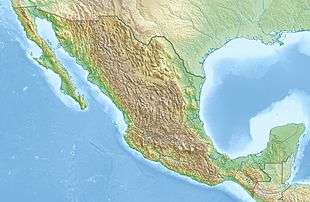Sistema Dos Ojos
| Sistema Dos Ojos | |
|---|---|
|
| |
 Sistema Dos Ojos Location in Mexico | |
| Location | Quintana Roo, Mexico |
| Coordinates | 20°19′29″N 87°23′31″W / 20.32472°N 87.39194°WCoordinates: 20°19′29″N 87°23′31″W / 20.32472°N 87.39194°W |
| Depth | 119.1 meters (391 ft)[1] |
| Length | 82.472 kilometers (51.246 mi)[1] |
| Discovery | November 1987 |
| Geology | Limestone |
| Entrances | 28 cenotes[1] |
| Difficulty | Advanced cave diving |
Dos Ojos (from Spanish meaning "Two Eyes"; officially Sistema Dos Ojos) is a flooded cave system located north of Tulum, on the Caribbean coast of the Yucatán Peninsula, in the state of Quintana Roo, Mexico. The exploration of Dos Ojos began in 1987 and still continues. The surveyed extent of the cave system is 82 kilometers (51 mi)[1] and there are 28 known sinkhole entrances, which are locally called cenotes.
Dos Ojos lies broadly parallel to and north of the Sac Actun cave system. Dos Ojos has remained in the top ten, if not the top three, longest underwater cave systems in the world since the late 1980s.[2] Dos Ojos contains the deepest known cave passage in Quintana Roo with 119.1 meters (391 ft) of depth located at "The Pit" discovered in 1996 by cave explorers who came all the way from the main entrance some 1,500 meters (4,900 ft) away. The deep passages include the "Wakulla Room", the "Beyond Main Base (BMB) passage", "Jill's room" and "The Next Generation passage". In August 2012 Dos Ojos was connected through a dry passage to Sistema Sac Actun. With March 2014 the total length of the combined system measures 319.05 kilometers (198.25 mi).
Dos Ojos is an anchialine cave system with connections to naturally intruding marine water and tidal influence in the cenotes. The coastal discharge point(s) of this cave system have not yet been humanly explored through to the ocean, although large volumes of groundwater were demonstrated by dye tracing to flow towards Caleta Xel-Ha, a nearby coastal bedrock lagoon.[3]
The name Dos Ojos refers to two neighbouring cenotes that connect into a very large cavern zone shared between the two. These two cenotes appear like two large eyes into the underground. The original cave diving exploration of the whole cave system began through these cenotes. The Dos Ojos underwater cave system was featured in a 2002 IMAX film, Journey Into Amazing Caves, and the 2006 BBC/Discovery Channel series Planet Earth. Parts of the Hollywood 2005 movie The Cave were filmed in the Dos Ojos cave system.
Water temperature is 25 °C or 77 °F throughout the year, and the maximum depth near the Dos Ojos cenotes is approximately 10 meters (33 ft). The water is exceptionally clear as a result of rainwater filtered through limestone, and there being very little soil development in this region since the limestone is very pure.
Fauna
There are several varieties of fish living in the cavern, the majority of which are well under 10 centimeters (3.9 in) long, and at least two types of freshwater shrimp.
Tourism
The Dos Ojos Cenotes are a popular snorkeling and cavern diving site receiving typically a hundred or more tourists per day. The majority of cavern dives are at 5–7 meters (16–23 ft). Most guided cavern dives include two dives in one day, each being 45 minutes long plus a 60-minute surface interval. It is possible to traverse underwater into another adjacent cenote called the "Bat Cave", which is also used for snorkeling. Visibility is excellent and generally limited by available light rather than water transparency.
Freediving Record
On November 3, 2010, Dos Ojos hosted Carlos Coste's record-breaking freedive. Coste swam 150 m (490 ft) on one breath and became the Guinness World Record holder for "Longest distance swam underwater with one breath (open water)".[4]
See also
 Underwater diving portal
Underwater diving portal- List of caves in Mexico
- List of sinkholes of Mexico
References
- 1 2 3 4 "List of Long Underwater Caves in Quintana Roo Mexico". Quintana Roo Speleological Survey. National Speleological Society. March 19, 2014. Retrieved March 23, 2014.
- ↑ Bob Gulden, Jim Coke (May 13, 2013). "World longest underwater caves". NSS Geo2 Committee on Long and Deep Caves. Retrieved June 11, 2013.
- ↑ Patricia A Beddows (February 2004) [2003]. J Gunn, ed. Yucatán Phreas (PDF). 2 (2nd ed.). New York: Fitzroy Dearborn / Taylor and Francis. pp. 1677–1681. ISBN 1-57958-399-7. Retrieved January 13, 2011.
- ↑ Guinness World Records
- Steve Gerrard (2000). The Cenotes of the Riviera Maya. ISBN 0-9677412-0-3. online Version. Retrieved January 13, 2011.
